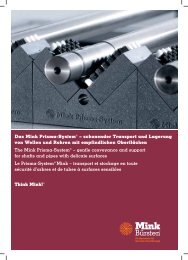Transmission Chain catalogue
Transmission Chain catalogue
Transmission Chain catalogue
Create successful ePaper yourself
Turn your PDF publications into a flip-book with our unique Google optimized e-Paper software.
<strong>Transmission</strong> Sprocket Details<br />
Sprockets for Roller <strong>Chain</strong><br />
Split<br />
Sprocket<br />
Necklace<br />
Sprocket<br />
Renold manufacture a comprehensive range of<br />
stock sprockets for British Standard chain up to<br />
two inch pitch.<br />
Other sizes of sprocket, including those to<br />
American Standard dimensions, are available<br />
on request.<br />
Special sprockets are also manufactured<br />
on request, in special materials or formats,<br />
normally to suit a specific application in harsh<br />
or difficult drive situations, examples being:<br />
• Sprockets incorporating shafts<br />
• Welded or detachable hubs<br />
• Shear pin devices fitted<br />
• Necklace sprockets made up of chain plates<br />
and individual tooth sections for turning<br />
large drums or tables<br />
• Combination sprockets (two or more<br />
sprockets combined having different<br />
pitch sizes and numbers of teeth)<br />
• Sprockets in two or more sections,<br />
i.e. split sprockets or segmental sprockets<br />
Sprocket Smooth Moderate Heavy<br />
Running Shocks Shocks<br />
EN8 or EN9 EN8 or EN9<br />
EN8 Hardened & Hardened &<br />
Up to or Tempered Tempered<br />
29T EN9 or Case or Case<br />
Hardened Hardened<br />
Mild Steel Mild Steel<br />
EN8 or EN9<br />
Hardened &<br />
30T and Mild Steel Tempered<br />
Over Cast Iron or or Case<br />
Meehanite Hardened<br />
Mild Steel<br />
Selection of sprocket materials<br />
Choice of material and heat treatment will<br />
depend upon shape, diameter and mass of<br />
the sprocket. The table above can be used as<br />
a simple guide on the correct selection of<br />
sprocket material.<br />
Sprocket and chain compatibility<br />
Most drives have an even number of pitches<br />
in the chain and by using a driver sprocket<br />
with an odd number of teeth, uniform wear<br />
distribution over both chain and sprocket teeth<br />
is ensured. Even numbers of teeth for both<br />
the driver and driven sprockets can be used,<br />
but wear distribution on both the sprocket<br />
teeth and chain is poor.<br />
Number of teeth<br />
The maximum number of teeth in any driven<br />
sprocket should not exceed 114. This limitation<br />
is due to the fact that for a given elongation of<br />
chain due to wear, the working pitch diameter<br />
of the chain on the sprocket increases in relation<br />
to the nominal pitch diameter, i.e. the chain<br />
assumes a higher position on the sprocket tooth.<br />
The allowable safe chain wear is considered to<br />
be in the order of 2% elongation over nominal<br />
length.<br />
A simple formula for determining how much<br />
chain elongation a sprocket can accommodate<br />
is 200<br />
N<br />
expressed as a percentage where N is the<br />
number of teeth on the largest sprocket in<br />
the drive system.<br />
Renold <strong>Transmission</strong> <strong>Chain</strong> Catalogue I 67<br />
Minimum six teeth<br />
It is good practice to have the sum of teeth not<br />
less than 50 where both the driver and driven<br />
sprockets are operated by the same chain, e.g.<br />
on a 1:1 ratio drive, both sprockets should have<br />
25 teeth each.<br />
Centre distance<br />
For optimum wear life, centre distance<br />
between two sprockets should normally be<br />
within the range 30 to 50 times the chain<br />
pitch. On drive proposals with centre distances<br />
below 30 pitches or greater than 2m, we would<br />
recommend that the drive details are discussed<br />
with our technical staff.<br />
The minimum centre distance is sometimes<br />
governed by the amount of chain lap on the<br />
driver sprocket, our normal recommendation<br />
in this circumstance being not less than six<br />
teeth in engagement with the chain.<br />
The centre distance is also governed by the<br />
desirability of using a chain with an even<br />
number of pitches to avoid the use of a cranked<br />
link, a practice that is not recommended except<br />
in special circumstances.<br />
For a drive in the horizontal plane, the<br />
shortest centre distance possible should be<br />
used consistent with recommended chain lap<br />
(minimum six teeth) on the driver sprocket.<br />
Section 1



